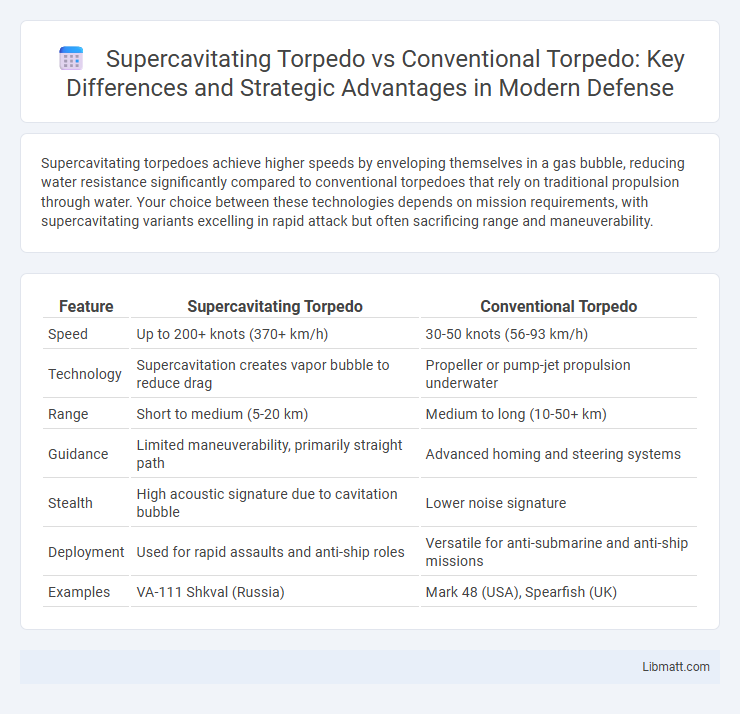Supercavitating torpedoes achieve higher speeds by enveloping themselves in a gas bubble, reducing water resistance significantly compared to conventional torpedoes that rely on traditional propulsion through water. Your choice between these technologies depends on mission requirements, with supercavitating variants excelling in rapid attack but often sacrificing range and maneuverability.
Table of Comparison
| Feature | Supercavitating Torpedo | Conventional Torpedo |
|---|---|---|
| Speed | Up to 200+ knots (370+ km/h) | 30-50 knots (56-93 km/h) |
| Technology | Supercavitation creates vapor bubble to reduce drag | Propeller or pump-jet propulsion underwater |
| Range | Short to medium (5-20 km) | Medium to long (10-50+ km) |
| Guidance | Limited maneuverability, primarily straight path | Advanced homing and steering systems |
| Stealth | High acoustic signature due to cavitation bubble | Lower noise signature |
| Deployment | Used for rapid assaults and anti-ship roles | Versatile for anti-submarine and anti-ship missions |
| Examples | VA-111 Shkval (Russia) | Mark 48 (USA), Spearfish (UK) |
Introduction to Torpedo Technology
Supercavitating torpedoes utilize the formation of a vapor cavity around the torpedo to drastically reduce water drag, enabling speeds exceeding 200 knots, whereas conventional torpedoes typically operate at speeds between 30 to 50 knots. The technology behind supercavitation involves injecting gas to create a bubble, allowing the torpedo to travel within this low-resistance cavity, contrasted with conventional torpedoes that rely on hydrodynamic propulsion and streamlined designs to minimize drag. This fundamental difference in propulsion and drag reduction mechanisms defines the performance and tactical applications of both torpedo types in modern naval warfare.
What is a Supercavitating Torpedo?
A supercavitating torpedo is a high-speed underwater missile designed to travel through a gas bubble, significantly reducing water resistance and enabling speeds exceeding 200 knots, unlike conventional torpedoes limited to around 50 knots. By creating a cavity of vapor around its body, the supercavitating torpedo minimizes drag and achieves rapid underwater travel, enhancing strike efficiency and tactical advantage. Understanding this technology can help you appreciate the revolutionary impact on naval warfare and underwater missile performance.
Conventional Torpedoes: Design and Operation
Conventional torpedoes utilize a propeller-driven system that allows them to travel underwater at speeds typically ranging from 30 to 50 knots, relying on water propulsion and hydrodynamic lift. Their design includes a sealed warhead, guidance system with sonar or wire control, and a propulsion engine powered by electric batteries or combustion. Due to water resistance, conventional torpedoes experience significant drag, limiting their speed and range compared to supercavitating torpedoes, which generate a vapor cavity to drastically reduce drag.
Speed Comparison: Supercavitating vs Conventional
Supercavitating torpedoes achieve speeds exceeding 200 knots by creating a gas bubble that drastically reduces water resistance, while conventional torpedoes typically travel at 30 to 50 knots due to direct water contact. This significant speed difference enables supercavitating torpedoes to reach targets faster, minimizing reaction time. Understanding this sharp contrast can help You evaluate the strategic advantages of advanced underwater weaponry in naval operations.
Maneuverability and Control Differences
Supercavitating torpedoes achieve higher speeds by enveloping themselves in a gas bubble, drastically reducing water resistance, but this limits their maneuverability compared to conventional torpedoes, which rely on hydrodynamic control surfaces for precise navigation. Your ability to effectively steer and adjust trajectory is greater with conventional torpedoes due to their slower speeds and responsive control fins, allowing for complex targeting in variable underwater environments. Supercavitating torpedoes sacrifice fine control for speed, resulting in less precise maneuvering and a simpler, more linear path once deployed.
Detection and Evasion Capabilities
Supercavitating torpedoes achieve significantly higher speeds by generating a gas bubble that reduces water drag, which drastically limits the reaction time available for detection and evasion systems compared to conventional torpedoes. Conventional torpedoes, operating at slower speeds, rely on acoustic homing and maneuverability for target tracking, making them more susceptible to sonar detection and countermeasures. The rapid velocity and erratic trajectory of supercavitating torpedoes challenge traditional sonar tracking and complicate evasive maneuvers, enhancing their stealth and lethality in naval warfare scenarios.
Range and Endurance Analysis
Supercavitating torpedoes achieve significantly higher speeds, reaching up to 200 knots compared to 50 knots for conventional torpedoes, but this increased velocity reduces their effective range to approximately 20 kilometers versus the 50-70 kilometers typical of traditional designs. The supercavitation process consumes more energy rapidly, resulting in shorter endurance times often under 5 minutes, whereas conventional torpedoes can operate for 15-30 minutes on battery or fuel propulsion. High drag reduction in supercavitating torpedoes optimizes speed at the cost of sustained operation, making them ideal for rapid strike scenarios rather than long-duration missions.
Deployment and Operational Scenarios
Supercavitating torpedoes enable ultra-fast underwater travel by creating a gas cavity around the hull, making them ideal for rapid response and high-speed interception in shallow coastal waters or narrow straits. Conventional torpedoes, with slower speeds but greater maneuverability and longer range, suit diverse deployment scenarios including open ocean warfare and precise target engagement. Your choice of torpedo depends on mission requirements such as speed, stealth, and operational environment.
Technological Challenges and Advancements
Supercavitating torpedoes face significant technological challenges such as maintaining stable gas cavitation at high speeds and ensuring precise maneuverability within the vapor bubble. Advancements in materials science, propulsion systems, and adaptive control algorithms have enabled improved bubble stability and enhanced underwater navigation. Conventional torpedoes primarily rely on hydrodynamic design and propulsion improvements but lack the extreme speed capabilities achievable through supercavitation technology.
Future Prospects in Underwater Weaponry
Supercavitating torpedoes represent a breakthrough in underwater weaponry, offering drastically higher speeds by enveloping themselves in a vapor bubble to reduce drag, enabling rapid target engagement far beyond the capabilities of conventional torpedoes. These advanced weapons leverage cutting-edge propulsion and cavitation control technology, promising enhanced stealth and maneuverability in complex maritime environments. Your investment in defense technology could benefit from monitoring developments in supercavitating torpedoes, as they are poised to redefine the strategic landscape of future naval combat.
supercavitating torpedo vs conventional torpedo Infographic

 libmatt.com
libmatt.com